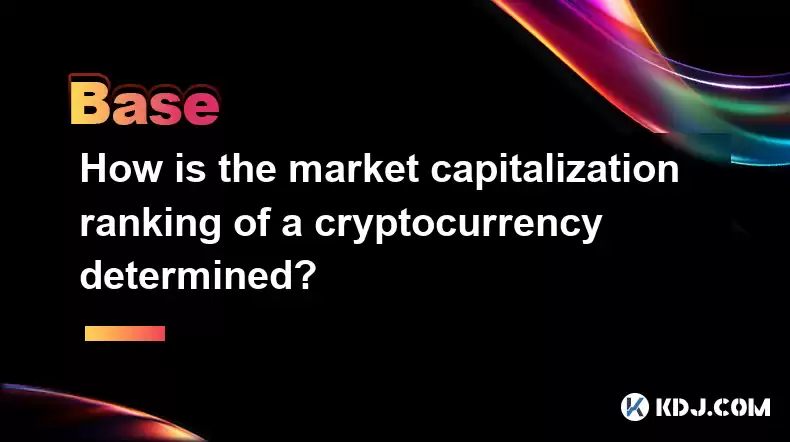-
 bitcoin
bitcoin $87959.907984 USD
1.34% -
 ethereum
ethereum $2920.497338 USD
3.04% -
 tether
tether $0.999775 USD
0.00% -
 xrp
xrp $2.237324 USD
8.12% -
 bnb
bnb $860.243768 USD
0.90% -
 solana
solana $138.089498 USD
5.43% -
 usd-coin
usd-coin $0.999807 USD
0.01% -
 tron
tron $0.272801 USD
-1.53% -
 dogecoin
dogecoin $0.150904 USD
2.96% -
 cardano
cardano $0.421635 USD
1.97% -
 hyperliquid
hyperliquid $32.152445 USD
2.23% -
 bitcoin-cash
bitcoin-cash $533.301069 USD
-1.94% -
 chainlink
chainlink $12.953417 USD
2.68% -
 unus-sed-leo
unus-sed-leo $9.535951 USD
0.73% -
 zcash
zcash $521.483386 USD
-2.87%
How is the market capitalization ranking of a cryptocurrency determined?
A cryptocurrency's market cap ranking, constantly fluctuating, is determined by multiplying its current price by its circulating supply (not total supply), offering a dynamic view of its overall market value.
Mar 17, 2025 at 04:01 pm

- Market capitalization is a crucial metric reflecting a cryptocurrency's overall value.
- It's calculated by multiplying the current market price of a coin by its total circulating supply.
- The circulating supply, not the total supply, is the key figure in this calculation.
- Rankings fluctuate constantly due to price volatility and changes in circulating supply.
- Understanding market cap helps assess a cryptocurrency's relative size and potential.
The market capitalization ranking of a cryptocurrency is a dynamic reflection of its overall value within the broader cryptocurrency market. This ranking is not a static measure; it shifts constantly based on several interconnected factors, primarily the cryptocurrency's price and its circulating supply.
Understanding the mechanics of market cap calculation is crucial to interpreting these rankings. Essentially, a cryptocurrency's market capitalization is calculated by multiplying its current market price (the price at which it's currently trading on exchanges) by its total circulating supply.
The crucial element here is "circulating supply." This represents the total number of coins or tokens that are currently in circulation and available for trading in the market. It excludes coins held in reserves, locked up in staking, or yet to be released into the market. The total supply, often a larger number including future releases, is irrelevant to the market cap calculation.
Therefore, even if a cryptocurrency has a massive total supply, a low circulating supply coupled with a high price can lead to a surprisingly high market capitalization and a high ranking. Conversely, a coin with a vast total supply but a low circulating supply and low price might have a low market cap.
Factors Affecting Cryptocurrency Market Cap Rankings:Several factors influence the constant flux in cryptocurrency market cap rankings. The most significant are:
- Price Volatility: Cryptocurrency prices are notoriously volatile. Even small price fluctuations can dramatically impact market cap, causing significant shifts in rankings. A sudden price surge can catapult a cryptocurrency up the rankings, while a price drop can quickly send it tumbling down.
- Changes in Circulating Supply: As more coins enter circulation through mining or unlocking events, the market cap can increase (assuming the price remains stable or increases), even if the price itself doesn't change. Conversely, a decrease in circulating supply, for example, due to burning mechanisms, can impact market cap.
- Market Sentiment: Investor sentiment plays a crucial role. Positive news, technological advancements, or widespread adoption can drive up prices and consequently, market capitalization, leading to a higher ranking. Conversely, negative news or regulatory uncertainty can lead to price drops and a lower ranking.
- Trading Volume: High trading volume generally suggests greater liquidity and market interest, which can positively influence price and therefore market capitalization. Low volume can indicate less interest, potentially impacting price and ranking.
Market capitalization data is sourced from various cryptocurrency tracking websites and exchanges. While these sources strive for accuracy, slight discrepancies can exist due to differences in data collection methods and the speed at which information is updated. It's advisable to consult multiple sources for a more comprehensive picture.
Obtaining accurate information requires understanding the methodology employed by different platforms. Some platforms might use different methodologies for calculating circulating supply, resulting in slight variations in reported market capitalization. This emphasizes the need for comparing data from several reputable sources.
Step-by-Step Example:Let's imagine a hypothetical cryptocurrency, "CryptoX." To understand how its market cap ranking is determined, let's follow these steps:
- Find the current market price: Let's say CryptoX is currently trading at $50.
- Determine the circulating supply: Suppose CryptoX has a circulating supply of 10 million coins.
- Calculate the market capitalization: Multiply the price by the circulating supply: $50 x 10,000,000 = $500,000,000. CryptoX's market cap is $500 million.
- Compare to other cryptocurrencies: CryptoX's market cap of $500 million is then compared to the market caps of other cryptocurrencies to determine its ranking. This ranking is dynamic and constantly changes.
A: No. Market capitalization is a valuable metric, but it shouldn't be the sole factor. Consider other factors like the project's technology, team, adoption rate, and regulatory landscape.
Q: Can a cryptocurrency with a lower market cap outperform one with a higher market cap?A: Absolutely. Market cap reflects current value, not future potential. Smaller cryptocurrencies with innovative technology or strong community support might experience significant growth, potentially outperforming larger, more established ones.
Q: How often are cryptocurrency market cap rankings updated?A: Rankings are updated in real-time or near real-time by most cryptocurrency tracking websites. However, minor delays might occur due to the volume of data and the speed of market fluctuations.
Q: What are the implications of a changing market cap ranking?A: A rising market cap ranking often indicates increased investor confidence and potentially higher demand. Conversely, a falling ranking can suggest decreased interest or concerns about the cryptocurrency's prospects. However, it’s crucial to analyze the underlying reasons for the change rather than focusing solely on the ranking itself.
Q: Are there any limitations to using market capitalization as an indicator of success?A: Yes. Market cap is susceptible to manipulation through artificial inflation of price or circulating supply. It also doesn't account for factors like development progress, community engagement, or the long-term vision of a project. Therefore, a holistic approach that includes multiple indicators is crucial for comprehensive evaluation.
Disclaimer:info@kdj.com
The information provided is not trading advice. kdj.com does not assume any responsibility for any investments made based on the information provided in this article. Cryptocurrencies are highly volatile and it is highly recommended that you invest with caution after thorough research!
If you believe that the content used on this website infringes your copyright, please contact us immediately (info@kdj.com) and we will delete it promptly.
- 1inch and Blockscan Revolutionize Cross-Chain Transactions with New Explorer
- 2025-12-16 01:10:02
- Solana's Shifting Narrative: Blockchain Dominance Meets Evolving Investor Focus, Analyzed by CoinGecko Data
- 2025-12-16 01:25:01
- Ueda's Bold Hand: Bank of Japan Charts New Course with Tightening Policy
- 2025-12-16 01:25:01
- Wet Token Splashes onto the Scene with Astounding Price Increase in Cryptocurrency Market
- 2025-12-16 01:00:01
- Navigating the Crypto Currents: Ethereum, Solana, XRP, and the Ozak AI Surge
- 2025-12-16 01:20:01
- SBP Policy Rate Cut Sparks Outcry: Business Community Demands Deeper Cuts for Economic Revival
- 2025-12-16 01:20:01
Related knowledge

What are the different consensus mechanisms beyond PoW and PoS?
Nov 28,2025 at 05:59am
Understanding Consensus Mechanisms in BlockchainBlockchain technology relies heavily on consensus mechanisms to validate transactions and maintain the...

What is an oracle in the context of blockchain?
Nov 29,2025 at 09:39pm
Understanding Blockchain Oracles1. A blockchain oracle serves as a bridge between a blockchain and external data sources. Smart contracts operate with...

How does a decentralized identity (DID) work on the blockchain?
Nov 30,2025 at 03:20am
Understanding Decentralized Identity (DID) Architecture1. A decentralized identity operates through a unique identifier that is registered on a blockc...

What is a node in a blockchain network and can I run one?
Dec 07,2025 at 03:19am
Understanding Blockchain NodesA node in a blockchain network refers to any computer that participates in the operation of the network by maintaining a...

How to spot fake crypto giveaways on social media?
Dec 06,2025 at 02:39am
Understanding the Mechanics of Fake Crypto Giveaways1. Scammers often create fake accounts that closely resemble verified profiles of well-known figur...

Coinbase vs. Kraken: Which exchange should I use?
Nov 28,2025 at 06:19pm
Coinbase vs. Kraken: A Comparative OverviewWhen selecting a cryptocurrency exchange, users often weigh factors such as security, fees, user experience...

What are the different consensus mechanisms beyond PoW and PoS?
Nov 28,2025 at 05:59am
Understanding Consensus Mechanisms in BlockchainBlockchain technology relies heavily on consensus mechanisms to validate transactions and maintain the...

What is an oracle in the context of blockchain?
Nov 29,2025 at 09:39pm
Understanding Blockchain Oracles1. A blockchain oracle serves as a bridge between a blockchain and external data sources. Smart contracts operate with...

How does a decentralized identity (DID) work on the blockchain?
Nov 30,2025 at 03:20am
Understanding Decentralized Identity (DID) Architecture1. A decentralized identity operates through a unique identifier that is registered on a blockc...

What is a node in a blockchain network and can I run one?
Dec 07,2025 at 03:19am
Understanding Blockchain NodesA node in a blockchain network refers to any computer that participates in the operation of the network by maintaining a...

How to spot fake crypto giveaways on social media?
Dec 06,2025 at 02:39am
Understanding the Mechanics of Fake Crypto Giveaways1. Scammers often create fake accounts that closely resemble verified profiles of well-known figur...

Coinbase vs. Kraken: Which exchange should I use?
Nov 28,2025 at 06:19pm
Coinbase vs. Kraken: A Comparative OverviewWhen selecting a cryptocurrency exchange, users often weigh factors such as security, fees, user experience...
See all articles










































































